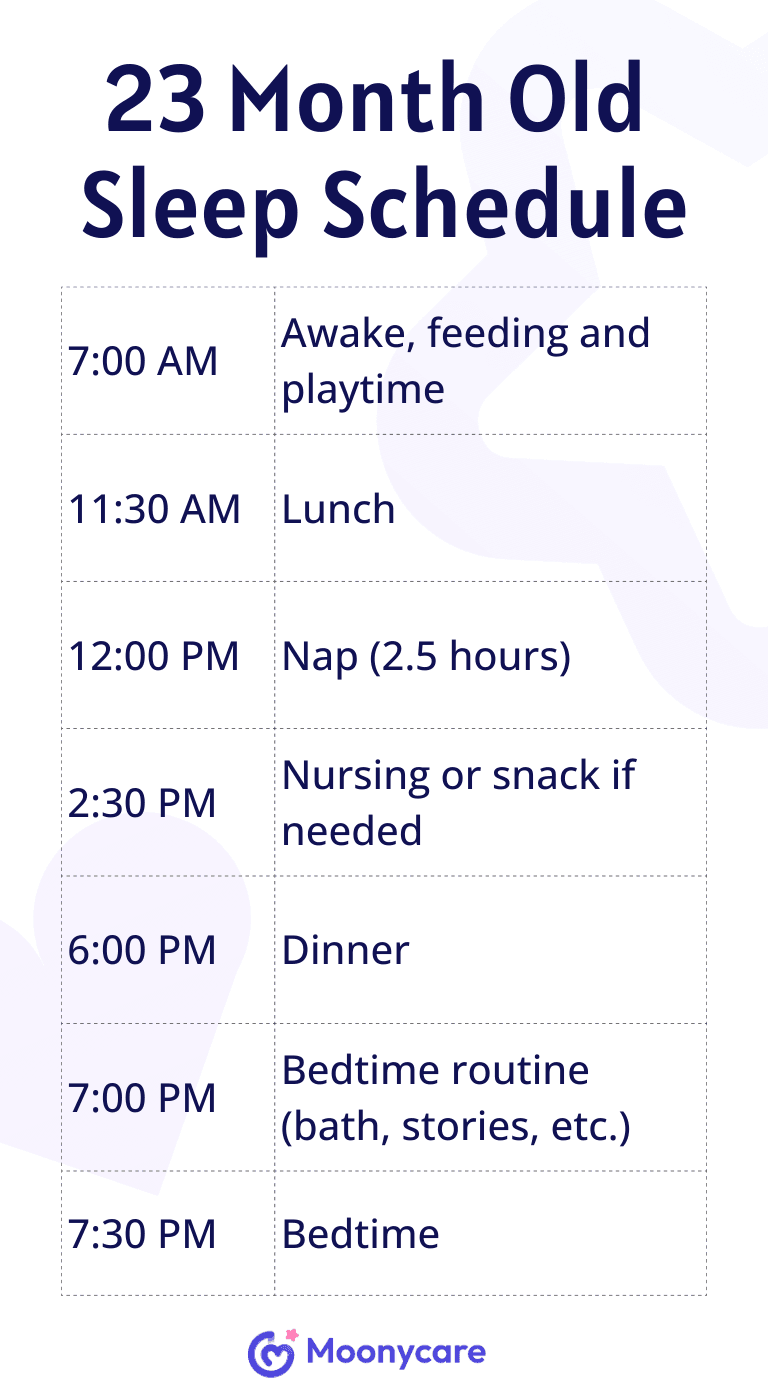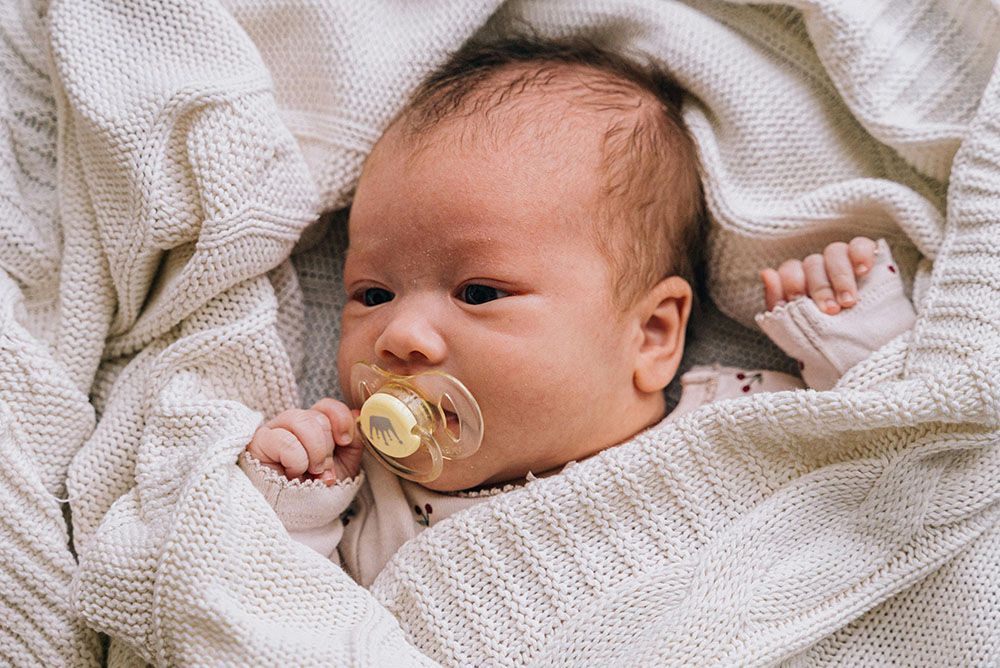

As your toddler approaches 23 months, you might notice some changes in their sleep patterns. With each passing month, your little one is becoming more independent and energetic, which often means their sleep needs evolve too. In this guide, we'll explore the sleep needs of 23-month-olds, offering practical tips and strategies to help you craft a balanced sleep schedule that supports their growing independence and energy levels.
IN THIS ARTICLE:
What are Wake Windows for a 23 Month Old?
A Sample Sleep Schedule for 23 Month Old Babies
How Much Should a 23 Month Old Sleep?
How Long Should a 23 Month Old Nap?
How Many Naps are Suitable for a 23 Month Old?
What Time Should a 23-Month-Old Go to Bed?
Can you Sleep Train a 23-Month-Old?
Is there Sleep Regression for 23 Month Old Babies?
What are Wake Windows for a 23-Month-Old?
Wake windows, are crucial for a well-balanced sleep schedule. At 23 months, the average wake window ranges from 4 to 6 hours. This means your toddler should ideally stay awake for about 5-6 hours after waking up in the morning before their nap and then another 4-5 hours between the end of the nap and bedtime. It's important to monitor your child for signs of tiredness, as pushing them beyond their wake window can lead to overtiredness, which can negatively impact their ability to fall asleep.
Sample 23-Month-Old Sleep Schedule
At 23 months, a typical sleep schedule might look like this:

This schedule ensures that your toddler gets the recommended amount of sleep while also accommodating their natural wake windows. But you don't have to carry out a completely same schedule, only if you baby can sleep well in his own pace.
How Much Should a 23-Month-Old Sleep?
At 23 months, toddlers generally need about 12 to 14 hours of sleep in a 24-hour period, including approximately 10 to 12 hours of nighttime sleep. Ensuring your toddler gets enough sleep is essential for their physical and cognitive development, as well as their overall mood and behavior.
How Long Should a 23-Month-Old Nap?
Baby at this age typically requires 2 to 3 hour for nap time. This nap helps to replenish their energy and maintain their mood throughout the day. If your toddler seems unusually cranky or overly energetic after nap time, you may need to adjust the nap's duration or timing.
How Many Naps are Expected for a 23-Month-Old?
At 23 months old, most toddlers have transitioned to a single nap per day. This nap typically occurs in the early afternoon, helping to rejuvenate your child for the rest of the day and preventing them from becoming overtired by bedtime. However, the exact timing and length of the nap can vary depending on your toddler's individual needs and daily activities. At the meantime, it's crucial to maintain a consistent nap schedule to support their overall sleep routine.
What Time Should a 23-Month-Old Go to Bed?
For a 23-month-old, bedtime is not just about a specific hour on the clock; it's a culmination of the day's activities, energy expenditure, and emotional readiness for sleep. Around this age, a bedtime between 7:00 PM and 8:00 PM is generally ideal, as it aligns with their natural circadian rhythm and allows for a full night's sleep. However, the key is to observe your child's cues like yawning, rubbing eyes, or becoming less active, and then make adjustments accordingly.
Besides, to fall asleep smoothly, you can also create a predictable and soothing bedtime routine before sleep, which can significantly ease the transition to sleep. Thus, you can do some gentle activities like reading a favorite book, gentle rocking, or a quiet lullaby, which can not only help in calming your toddler, but also in establishing a sense of security. The winding-down period should start about 30 minutes before the set bedtime, allowing your child to relax and disengage from the day's stimulation.
Besides, try to keep bedtime the same even on weekends or after a particularly active day. This regularity reinforces their internal clock and makes falling asleep easier. On days when your child seems more tired or irritable, you might consider moving bedtime slightly earlier to prevent overtiredness, which can actually make it harder for them to fall asleep.
Sleep Training a 23-Month-Old
If sleep issues persist, sleep training might be necessary. At 23 months, except for creating a comfortable environment for baby, there are many other effective strategies to help you navigate sleep training with your 23-month-old. And consistency and patience are crucial during this process.
1. Gradual Extinction (Ferber Method)
-
Gradual Separation: Start by sitting next to your child's crib or bed until they fall asleep. Gradually move farther away each night until you can leave the room.
-
Check-Ins: If your child wakes up, wait a few minutes outside the room before checking in. Gradually increase the intervals between check-ins.
2. Chair Method
-
Stay in the Room: Sit in a chair near your child's crib or bed and gradually move farther away as they become more comfortable.
-
Quiet Presence: Stay calm and reassuring, but avoid engaging in activities that might stimulate your child.
3. Address Nighttime Fears
-
Night Lights: Use a soft night light to ease any fears of the dark.
-
Comfort Items: Allow a favorite stuffed animal or blanket to provide comfort during the night.
4. Manage Separation Anxiety
-
Reassurance: Offer reassurance that you will be nearby and come back to check on them.
-
Transitions: Gradually increase the distance between you and your child during bedtime.
Sleep Regression of a 23-Month-Old
Sleep regression at 23 months can be a challenging phase for both parents and toddlers. Unlike the earlier sleep regressions that may have been more physically driven, this stage is often influenced by cognitive and emotional developments. Your toddler is growing more aware of their surroundings, their emotions, and their independence, which can manifest in disrupted sleep patterns.
At this age, your child might start resisting naps or bedtime, waking up more frequently during the night, or having difficulty falling back asleep. These changes are often linked to the emergence of separation anxiety, fear of the dark, or an increase in nightmares or night terrors. The desire for independence can also lead to power struggles at bedtime, as your toddler may start testing boundaries or insisting on staying awake longer.
This regression is a normal part of development and usually resolves on its own as your toddler adjusts to their new cognitive and emotional abilities. With understanding and a supportive approach, you can help your child navigate this phase, leading to better sleep for both of you.
23-Month-Old Sleep Tips
-
Consistency: Stick to a regular bedtime routine to help your child wind down.
-
Comfort: Ensure your toddler's sleep environment is conducive to rest, with the room being dark, quiet, and at a comfortable temperature.
-
Routine: Establish a calming pre-bedtime routine, such as reading a story or taking a bath.
-
Be patient: Patience is key to navigate some sleep issues and keep good habits.
-
Seek Professional Help:If you're struggling to resolve sleep issues, consider consulting a pediatrician or a sleep specialist for personalized advice.






